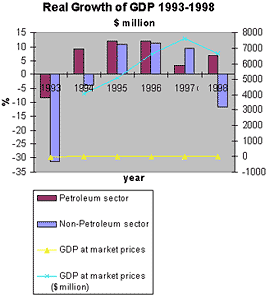 Finance Finance |
 back to market principles back to market principles |
The fall of the Berlin Wall in 1989 marked the beginning of the decline of Soviet influence in Africa. At the time, Angola joined many African states moving away from soviet sponsored Marxist-Leninist policies, embarking on the brighter yet bumpy transition to a western style democracy driven by market forces.
In fact, the reform of Angola's economy can be traced as far back as 1987. Since then nine successive economic reform packages have attempted to tackle the problems of rising urban poverty, the collapse of industrial and farming output and the huge macroeconomic imbalances brought on by the war and the structural failures of a planned economy.

The basic weakness of previous reform programs has been the lack of synchronization of policy measures. Successive devaluation were not accompanied by sufficient fiscal and monetary restraint thus contributing to spiraling inflation. In such an environment, the fixed exchange rate system led to the development of a parallel foreign currency market adding pressure against the Kwacha and pushing inflation even higher. Additionally, the absence of tradable instruments to finance budget deficits pushed the government to go to the printing press thus contributing to hyperinflation.
Such results led President Dos Santos to appoint a new economic team in early 1999 including the present governor of the central bank, Aguinaldo Jaime. In a recent seminar held in Luanda, Mr. Jaime described his latest economic reform program as the best designed package of economic reforms since the beginning of the country's transition to a market economy.
Indeed, the package introduced in May 1999 responds to long standing IMF demands. The fixed exchange rate system has been abolished allowing the Kwanza's exchange rate to be determined by market forces and budget deficits are now financed by the introduction of treasury bills. Other changes include the partial liberalization of the import regime and the banking sector.
By requesting, since April of last year, that its economic program be formulated in consultation with the staff of the IMF, the Angolan government is continuing to affirm its commitment to long-standing and coherent economic reform.
Angola is a member of the IMF but so far does not qualify for structural reform loans. The IMF staff monitored program is a step in the right direction. Its latest report published in February mentions progress in introducing 'a number of important structural reforms' notably going ahead with the diagnostic study of the oil sector won by KPMG and allowing a similar independent audit to be done on the BNA, Angola's central bank. A five year contract has also been signed with Crown Agents a British company specializing in the modernization of customs administration. A decree abolishing restrictive import licensing has also been published. The privatization plan for state owned banks and enterprises has now been prepared and an inventory of domestic public debt and intra-public sector arrears have been completed.
| Apart from the war, inflation remains the No.1 obstacle for reducing poverty and promoting economic development in Angola. In 2000, inflation rose by 268%. The government aims to bring that figure down to 75% by December 2001. This may seem enormous to readers used to a stable currency; monetary discipline and single digit inflation but these are new rules for a young market economy that only recently accepted the challenge of globalization. Considering inflation in Angola averaged 1227% per annum between 1995 and 1999, the government can safely say that it is on the right track.

However, often-inadequate expenditure controls combined with unbudgeted transactions and a strong dependence on oil revenues to satisfy the country's consumption needs, remain sore points for Angola's ruling elite. While efforts have been made in all these areas, there is still room for improvement in the control of fiscal imbalances and the preventing of an over-expansive monetary policy. This possibly explains the government's decision to extend the staff monitored program at least until June 2001. Another important factor affecting this decision involves Angola's debt reform strategy.
Throughout the nineties, Angola's deep economic crisis led to default on a large proportion of its foreign debt, the subsequent breakdown of normal relations with bilateral creditors and the accumulation of costly non-concessional debts with commercial lenders. According to the IMF, Angola's debt stock amounted to US$ 8,3 billion (95% of GDP) at end of September 2000, of which US$ 4 billion was in arrears. However, by January 2001 the government had cleared all arrears to multinational creditors including the Arab Development Bank and the African Development Bank to which it owed US$75 million.
By diminishing its external debt and introducing long awaited economic reforms, the government is improving its credit worthiness and gradually reducing its dependence on costly non-concessional commercial loans. This may explain the central bank governor's satisfaction with his package of economic reforms and the staff monitored program as Angola is thus on course for qualifying for the IMF's Poverty Reduction Growth Facility (PRGF). Such a turn of events could help catalyze fresh disbursements from multilateral creditors and donors as well as induce a return to normal relations with bilateral creditors. |

